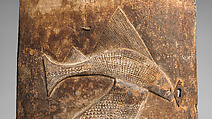Door (Anuan)
Not on view
Baule carving traditions embrace embellished functional objects, mask forms that enhance performances and sculptures that facilitate relations with the spirit world. Wooden doors known as anuan, adorned with human, animal, and vegetal motifs, were once produced by Baule carvers to embellish entrances to public and private spaces such as courtyards and rest houses. The carvers used the rectangular surface of the doors as canvases to elaborate in low or high relief scenes that are either purely decorative, or that allude to proverbs and myths.
A common motif is that of aquatic beings, such as crocodiles and fish. In this example a large fish, positioned vertically to fill most of the door's surface, seizes in its mouth a smaller fish, positioned horizontally. The depiction of the piscine creatures is highly stylized and the fish seem to merge into one another. The overall composition, even though it is expressed on a flat surface, feels three-dimensional and sculptural. While some elements of the scene could be described as stiff (such as the fish's tales and fins that show no motion), movement is created by the delicately incised scales of varying linear and geometric shapes and dimensions that animate the animals' skin surfaces, and the fluid junction of their two heads. In addition to the visible wear of the wood, several elements attests to this door's extensive use and repeated care by its owner(s): a hole at the center of the door would have allowed for a cord to function as a handle or knob, while a keyhole can be found at the tip of the smaller fish's head. A crack in the wood on the upper left section was repaired with strips of metal.
As Baule art specialist Susan Vogel has stated, this scene bears many interpretations, mostly social ones, connected to the relationship between the weak and the powerful or referring to social order. It has also been suggested that the predominance of aquatic beings is connected to mythical events pertaining to the original migration of Baule peoples from present-day Ghana to present-day Côte d'Ivoire in the 18th century. According to that legend, Queen Abla Poku was responsible for guiding her people on an exodus out of Asante. A critical juncture in this journey was her son's sacrifice to allow her people to cross the Comoé River into what was to become their new territory. Fish are rarely depicted on Baule art forms other than doors. As such, their prominence as motifs on door slabs might allude to the foundational notion of water as threshold.
Yaëlle Biro, June 2016
References:
Barbier, Jean Paul Ed. Art of Côte d'Ivoire from the collections of the Barbier-Mueller Museum, Vol. I and II. Geneva: The Barbier-Mueller Museum, 1993
Holas, Bohumil. Portes sculptées du Musée d'Abidjan. Institut Français d'Afrique Noire. Catalogues, X. Dakar: IFAN, 1952
Vogel, Susan M.. Baule: African Art, Western Eyes. New Haven: Yale University Press, 1997
Due to rights restrictions, this image cannot be enlarged, viewed at full screen, or downloaded.
This artwork is meant to be viewed from right to left. Scroll left to view more.




